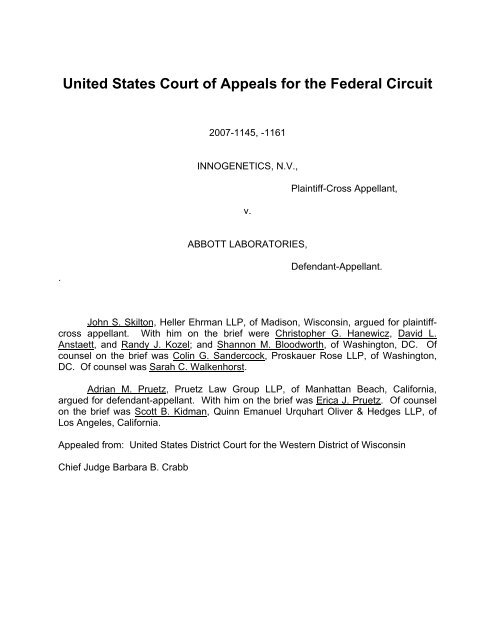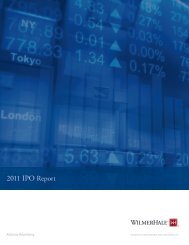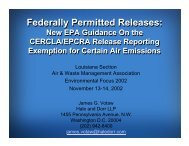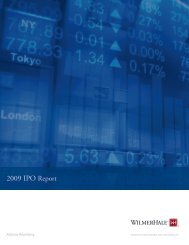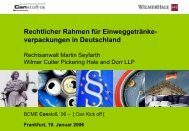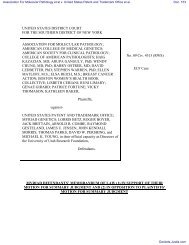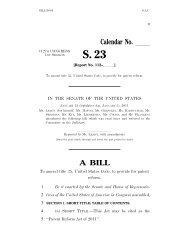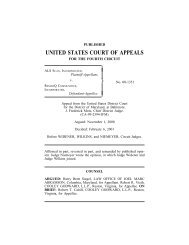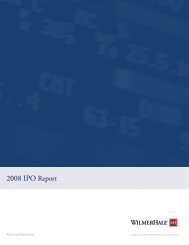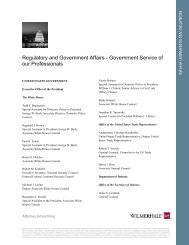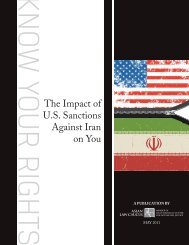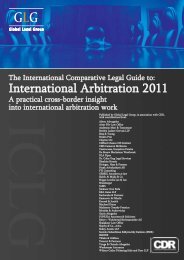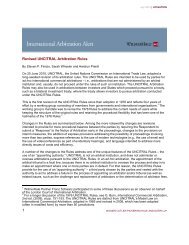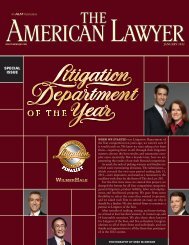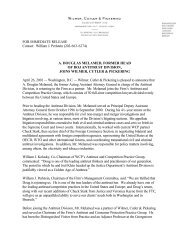Innogenetics, N.V. v. Abbott Laboratories - WilmerHale
Innogenetics, N.V. v. Abbott Laboratories - WilmerHale
Innogenetics, N.V. v. Abbott Laboratories - WilmerHale
Create successful ePaper yourself
Turn your PDF publications into a flip-book with our unique Google optimized e-Paper software.
United States Court of Appeals for the Federal Circuit2007-1145, -1161INNOGENETICS, N.V.,v.Plaintiff-Cross Appellant,ABBOTT LABORATORIES,.Defendant-Appellant.John S. Skilton, Heller Ehrman LLP, of Madison, Wisconsin, argued for plaintiffcrossappellant. With him on the brief were Christopher G. Hanewicz, David L.Anstaett, and Randy J. Kozel; and Shannon M. Bloodworth, of Washington, DC. Ofcounsel on the brief was Colin G. Sandercock, Proskauer Rose LLP, of Washington,DC. Of counsel was Sarah C. Walkenhorst.Adrian M. Pruetz, Pruetz Law Group LLP, of Manhattan Beach, California,argued for defendant-appellant. With him on the brief was Erica J. Pruetz. Of counselon the brief was Scott B. Kidman, Quinn Emanuel Urquhart Oliver & Hedges LLP, ofLos Angeles, California.Appealed from: United States District Court for the Western District of WisconsinChief Judge Barbara B. Crabb
United States Court of Appeals for the Federal Circuit2007-1145, -1161INNOGENETICS, N.V.,Plaintiff-Cross Appellant,v.ABBOTT LABORATORIES,Defendant-Appellant.Appeals from the United States District Court for the Western District of Wisconsin incase no. 05-CV-0575, Judge Barbara B. Crabb.____________________________DECIDED: January 17, 2008____________________________Before BRYSON, Circuit Judge, CLEVENGER, Senior Circuit Judge, and MOORE,Circuit Judge.MOORE, Circuit Judge.<strong>Abbott</strong> <strong>Laboratories</strong> (<strong>Abbott</strong>) appeals on a multitude of grounds the judgmententered against it by the United States District Court for the Western District ofWisconsin for infringement of <strong>Innogenetics</strong>, N.V.’s (<strong>Innogenetics</strong>) U.S. Patent No.5,846,704 (the ’704 patent). We reverse and remand for a new trial the district court’sjudgment as a matter of law that claim 1 of the ’704 patent was not anticipated by U.S.Patent No. 5,580,718 (the Resnick patent). We also vacate the permanent injunctiongranted against <strong>Abbott</strong>. As for the whole host of other issues that <strong>Abbott</strong> raises on
appeal, we find no reversible error and affirm the lower court’s judgment in thoserespects. <strong>Innogenetics</strong> cross-appeals the district court’s judgment as a matter of lawthat <strong>Abbott</strong>’s infringement was not willful. Under the standards recently articulated in Inre Seagate Technology, LLC, 497 F.3d 1360 (Fed. Cir. 2007) (en banc), we also affirmthat aspect of the lower court’s judgment.BACKGROUNDThe technology in this case pertains to diagnostic tools that not only detect butalso classify hepatitis C virus (HCV) genotypes in a biological sample, which facilitatestailoring the treatment of patients with different genotypes. The ’704 patent claims amethod of genotyping HCV based on distinct genetic sequences that can be found inthe 5 prime untranslated region (5’ UTR) of the HCV genome. This method teachesspecifically hybridizing probes, or short strands of nucleic acids, to a target sequence inthe 5’ UTR via complementary base pairing principles, and then detecting the formationof any complexes formed between the probes and the nucleic acids of the 5’ UTR.<strong>Abbott</strong>’s genotyping assay kits, like the method claimed in the ’704 patent, alsoinvolve specifically hybridizing probes to the nucleic acids of the HCV’s 5’ UTR. Thekits then detect the successful formation of any specifically hybridized complexes usingthe process of Realtime polymerase chain reaction (PCR). Through this process, dyemolecules attached to <strong>Abbott</strong>’s probes are released and observable as fluorescentsignals after polymerase enzymes destroy the hybridized probe-target complexes.<strong>Innogenetics</strong> sued <strong>Abbott</strong>, asserting that <strong>Abbott</strong>’s genotyping assay kits infringeclaims 1, 2, and 3 of the ’704 patent. Claim 1, the only independent claim on appeal,reads in its entirety as follows:2007-1145, -1161 2
A method of genotyping HCV present in a biological sample comprisinghybridizing nucleic acids in a biological sample with at least one probe anddetecting a complex as formed with said probe and said nucleic acids ofHCV, using a probe that specifically hybridizes to the domain extendingfrom the nucleotides at positions -291 to -66 of the 5’ untranslated regionof the HCV.’704 col.113 ll.1-7.<strong>Abbott</strong> moved for summary judgment, asserting that its kits were not infringing,that the ’704 patent was invalid, and that the ’704 patent had been procured byinequitable conduct. In its order denying <strong>Abbott</strong>’s motions, the district court construedthe claim limitation “detecting a complex as formed” to mean “detecting a complex thatis or has been formed.” The district court also construed the limitation in the preamble,“method of genotyping,” to mean “[a] method that distinguishes among types and/orsubtypes of hepatitis C virus (HCV) and classifies the HCV into a genotype or subtype.”On cross motions for summary judgment, the district court denied <strong>Abbott</strong>’s motion andgranted <strong>Innogenetics</strong>’ motion, concluding that <strong>Abbott</strong> had failed to adduce sufficientevidence to require a trial on the issue of inequitable conduct. Furthermore, the districtcourt deemed <strong>Abbott</strong>’s inequitable conduct claim “exceptional” and awarded attorney’sfees to <strong>Innogenetics</strong>.At the final pre-trial conference, the district court granted <strong>Innogenetics</strong>’ motion inlimine and excluded testimony on obviousness by <strong>Abbott</strong>’s witness, Dr. Patterson.However, the written order commemorating the conference rulings inaccurately statedthat defendant was precluded from entering any evidence of obviousness at trial.Aware of the mistake, <strong>Abbott</strong> nonetheless never moved for correction or reconsiderationof the written order, noting only that it wished to preserve an objection on the issue.Additionally, the district court precluded the following evidence related to anticipation:2007-1145, -1161 3
1) U.S. Patent No. 6,071,693 (the Cha patent) on the grounds that <strong>Abbott</strong> did notdisclose the patent as an anticipating prior art reference until the last day of discoveryand 2) any testimony beyond the actual words and content of the Cha PCT applicationfrom Dr. Cha, the inventor of the Cha patent and the Cha PCT application, on thegrounds that he had not been tendered as an expert witness and that an expert reporthad not been submitted.Because <strong>Abbott</strong> conceded that its entire noninfringement argument had beenpredicated on a construction of the claims that the court had not adopted, the districtcourt entered judgment as a matter of law of literal infringement against <strong>Abbott</strong> for literalinfringement of claims 1, 2, and 3 of the ’704 patent. The case then proceeded to abifurcated jury trial with only <strong>Abbott</strong>’s affirmative defense of anticipation tried during theliability phase. At trial, <strong>Abbott</strong> presented the international patent application for theinvention claimed in the Cha patent and the testimony of its expert, Dr. Bruce Patterson,that the Resnick patent anticipated claim 1 of the ’704 patent. However, before thecase went to the jury, the district court granted judgment as a matter of law of noanticipation by the Resnick patent based on its determination that Dr. Patterson’stestimony “rested on an inaccurate understanding of the construction of the limitation‘genotyping.’” The jury concluded that claim 1 of the ’704 patent was not anticipated. 1During the damages phase of trial, the jury awarded $7 million in damages to<strong>Innogenetics</strong> and found <strong>Abbott</strong>’s infringement to be willful.Post-trial, the district court denied <strong>Abbott</strong>’s motion for a new trial on infringementand invalidity and for judgment as a matter of law or a new trial on damages. However,1The jury did not decide the validity of claims 2 and 3, as they weredependent on claim 1.2007-1145, -1161 4
the district court did grant <strong>Abbott</strong>’s motion for judgment as a matter of law thatinfringement was not willful. The district court also granted <strong>Innogenetics</strong>’ motion for apermanent injunction.On appeal, <strong>Abbott</strong> challenges a myriad of issues, including the district court’sclaim construction, summary judgment of literal infringement, evidentiary exclusions asto <strong>Abbott</strong>’s obviousness and anticipation defenses, judgment as a matter of law that theResnick patent did not anticipate claim 1 of the ’704 patent, summary judgment of noinequitable conduct, award of attorney’s fees to <strong>Innogenetics</strong> for <strong>Abbott</strong>’s counterclaimof inequitable conduct due to its exceptionality, and grant of a permanent injunction. Oncross-appeal, <strong>Innogenetics</strong> challenges the district court’s judgment as a matter of lawoverturning the jury verdict of willful infringement. We address each of these issues inturn.ANALYSISI. INFRINGEMENTA. Claim ConstructionWe begin our inquiry with the district court’s claim construction, which we reviewde novo. Cybor Corp. v. FAS Techs., Inc., 138 F.3d 1448, 1456 (Fed. Cir. 1998) (enbanc). <strong>Abbott</strong> takes umbrage with the district court’s construction of the two-letter word“as” from the claim limitation “detecting a complex as formed with said probe and saidnucleic acids of HCV.” According to <strong>Abbott</strong>, the word “as” limits the claims at issue todetecting hybridized complexes in a contemporaneous manner. Hence, <strong>Abbott</strong> assertsthat its products are not encompassed by the ’704 patent because they detect theformation of a hybridized complex through the observation of fluorescence emitted after2007-1145, -1161 5
the complex has been destroyed, and not the actual complex itself. We conclude thatthe claim language makes no such distinction. <strong>Abbott</strong>’s proposed construction undulylimits the claims of the ’704 patent by divorcing the word “as” from its full context, “asformed with said probe and said nucleic acids of HCV.” The district court properlyconstrued the claim limitation as detecting the formation of probe-target complexes,regardless of whether the method of detecting requires destroying the probe-targetcomplex itself.In determining the meaning of a disputed claim limitation, we look primarily to theintrinsic evidence of record, examining the claim language, the written description, andthe prosecution history. Phillips v. AWH Corp., 415 F.3d 1303, 1312 (Fed. Cir. 2005)(en banc). Words of a claim “are generally given their ordinary and customary meaning”as understood by a person of ordinary skill in the art. Id. at 1312-13. Claims are read inview of the specification, which is the single best guide to the meaning of disputedterms. Id. at 1315. “In examining the specification for proper context, however, thiscourt will not at any time import limitations from the specification into the claims.”CollegeNet, Inc. v. ApplyYourself, Inc., 418 F.3d 1225, 1231 (Fed. Cir. 2005) (citingTeleflex, Inc. v. Ficosa N. Am. Corp., 299 F.3d 1313, 1326 (Fed. Cir. 2002)).A plain reading of the claim limitation suggests that it does just what it says—itdetects the formation of a complex between a probe and nucleic acids of the HCV.Nowhere does the claim language suggest that it only detects the complex itself.Indeed, in an expert report submitted by <strong>Innogenetics</strong>, Dr. William Reznikoff, amolecular genetics expert, opined that, in the context of the entire patent and itsprosecution history, one ordinarily skilled in the art would understand claim 1 to include2007-1145, -1161 6
detecting any complexes that have been formed. <strong>Abbott</strong> provides no expert opinions onhow a person ordinarily skilled in the art would have a different understanding of theclaim limitation. Nor does <strong>Abbott</strong> ever contest the credibility of Dr. Reznikoff’sunderstanding.While we may not be in as able a position as the district court to ferret out thecredibility of an expert, Dr. Reznikoff’s reading is supported by the intrinsic evidence.The specification of the ’704 patent explicitly states that the detection of hybrids “may bedetermined by means of colorimetric, fluorescent, radiometric detection or any othermethod comprised in the state of the art.” ’704 Patent col.6 ll.36-43 (emphasis added).<strong>Abbott</strong> contends that the written description constricts the claim limitation to a method ofcontemporaneous detection because the described embodiments all feature detectionof an actual complex. However, as is well established, an applicant is not required todescribe in the specification every conceivable and possible future embodiment of hisinvention. SRI Int’l v. Matsushita Elec. Corp. of Am., 775 F.2d 1107, 1121 (Fed. Cir.1985). Given the sparse but broad statements in the specification about how theclaimed invention detects hybridized complexes, see ’704 Patent col.6 ll.36-43, col.20ll.16-28, col.20 ll.41-42, <strong>Abbott</strong>’s reading of the process of detection improperly narrowsthe claim language.Lastly, relying on various dictionaries, <strong>Abbott</strong> argues that the word “as” iscorrectly defined as “at the same time that: while.” <strong>Abbott</strong>’s reliance on a singledictionary definition without explanation—especially where “as” has multiplemeanings—commits the very error of construction that we warned against in Phillips.See 415 F.3d at 1321 (“The main problem with elevating the dictionary to such2007-1145, -1161 7
proposed jury instruction, rather than by bringing the matter directly to the attention ofthe court and opposing counsel.”We review procedural issues not unique to patent law under regional circuit law.Bowling v. Hasbro, Inc., 403 F.3d 1373, 1375 (Fed. Cir. 2005). Absent extraordinarycircumstances, the Seventh Circuit has stated that it rarely reaches forfeited argumentsin civil litigation. Ocean Atl. Dev. Corp. v. Aurora Christian Sch., Inc., 322 F.3d 983,1005 (7th Cir. 2003). <strong>Abbott</strong>’s belief that “there was no need to raise [its argument] priorto the court adopting a claim construction not proposed by either party” falls well short ofextraordinary. Accordingly, we affirm the district court’s finding that <strong>Abbott</strong> had beenfully heard on the issue of literal infringement and that there was no legally sufficientevidentiary basis for a reasonable jury to find for <strong>Abbott</strong> on that issue. See Fed. R. Civ.P. 50.It should be noted that, forfeiture aside, <strong>Abbott</strong>’s argument lacks merit.Essentially, <strong>Abbott</strong> argues that a patent can never be literally infringed by embodimentsthat did not exist at the time of filing. Our case law allows for after-arising technology tobe captured within the literal scope of valid claims that are drafted broadly enough. SeeSuperGuide Corp. v. DirecTV Enters., Inc., 358 F.3d 870, 878-80 (Fed. Cir. 2004)(finding that the claim limitation “regularly received television signal” is broad enough toencompass digital signals even though no televisions that could receive digital signalsexisted as of the filing date).Additionally, <strong>Abbott</strong> itself has put forth evidence that Realtime PCR did in factexist by the time the inventors filed their PCT application in 1992, and by the time theyapplied for the ’704 patent in 1994. In his expert report, <strong>Abbott</strong>’s witness, Dr. Bruce2007-1145, -1161 9
Patterson, stated that “Realtime PCR using 5’ to 3’ exonuclease activity was pioneeredaround 1991 . . . .” <strong>Abbott</strong> does not dispute this evidence. We have no reason todisturb the district court’s grant of JMOL as to literal infringement.II. INVALIDITY<strong>Abbott</strong> challenges the district court’s denial of its motion for a new trial on theissue of invalidity on a number of evidentiary exclusions. Regional circuit law governsour review of motions for a new trial. EMI Group N. Am., Inc. v. Cypress SemiconductorCorp., 268 F.3d 1342, 1348 (Fed. Cir. 2001). Under Seventh Circuit law, the districtcourt’s denial of a motion for a new trial is reviewed for abuse of discretion. See Naeemv. McKesson Drug Co., 444 F.3d 593, 605 (7th Cir. 2006). A new trial may be grantedwhere “the verdict is against the weight of the evidence, the damages are excessive, orif for other reasons the trial was not fair to the moving party.” Id. (internal quotationsomitted). Evidentiary rulings are also reviewed for abuse of discretion. Wollenburg v.Comtech Mfg. Co., 201 F.3d 973, 977 (7th Cir. 2000) (citations omitted).A. Obviousness<strong>Abbott</strong> contends that it was clear error for the district court to preclude <strong>Abbott</strong>’sobviousness defense.During the discovery period, the district court granted<strong>Innogenetics</strong>’ motion to strike Dr. Patterson’s supplemental expert report because itviolated the court’s earlier order on the filing of such supplemental reports. <strong>Abbott</strong> doesnot contest that ruling. This left <strong>Abbott</strong> with only Dr. Patterson’s original expert reportfor his planned testimony on obviousness. The district court determined that the reportwas insufficient to support a jury finding of obviousness and thus failed the requirementsof Federal Rule of Civil Procedure 26(a). Therefore, at the final pretrial conference, it2007-1145, -1161 10
granted <strong>Innogenetics</strong>’ motion in limine, and excluded Dr. Patterson from testifying aboutobviousness at trial.However, the written order commemorating the conference rulings inaccuratelystated that defendant was precluded from entering any evidence of obviousness at trial.Aware of the mistake, <strong>Abbott</strong> nonetheless never moved for correction or reconsiderationof the written order. Instead, it advised plaintiff’s counsel in writing that it would not becontesting the written ruling and would put in no evidence of obviousness. <strong>Abbott</strong>confirmed this decision on the first day of trial, noting only that it wished to preserve anobjection on the issue. Post-trial, the district court denied <strong>Abbott</strong>’s Rule 50(b) motion fora new trial on obviousness because <strong>Abbott</strong>, despite its knowledge from the verybeginning that the written order was inaccurate, was only then seeking correction byway of overturning the jury’s unfavorable verdict against it. <strong>Abbott</strong> now appeals thedistrict court’s denial of its motion for a new trial on obviousness on the grounds that Dr.Patterson’s testimony on the issue was excluded and that, furthermore, no otherevidence on the issue was allowed. Because the district court’s rulings were not anabuse of discretion, we leave the jury verdict intact.1. Dr. Patterson’s testimonyThe district court did not err in finding that Dr. Patterson’s report on the allegedobviousness of the asserted claims of the ’704 patent was deficient for purposes ofdisclosure under Rule 26. For each of the claims that he analyzes for obviousness, Dr.Patterson merely lists a number of prior art references and then concludes with thestock phrase “to one skilled in the art it would have been obvious to perform the2007-1145, -1161 11
genotyping method in [claims 1-9 & 12-13] of the ’704 patent.” 2“[T]here must be somearticulated reasoning with some rational underpinning to support the legal conclusion ofobviousness.” In re Kahn, 441 F.3d 977, 988 (Fed. Cir. 2006); see also KSR Int’l Co. v.Teleflex Inc., 127 S. Ct. 1727, 1741 (2007) (“To facilitate review, this analysis should bemade explicit.”) (citing Kahn, 441 F.3d at 988). Nowhere does Dr. Patterson state howor why a person ordinarily skilled in the art would have found the claims of the ’704patent obvious in light of some combination of those particular references. As thedistrict court found: “It is not credible to think that a lay jury could examine the Chaapplication, the Resnick ’718 patent that defendant cited as prior art or any of the otherreferences and determine on its own whether there were differences among them andthe ’704 patent.” <strong>Innogenetics</strong>, N.V. v. <strong>Abbott</strong> Labs., No. 05-C-0575-C, slip op. at 14(W.D. Wis. Jan. 3, 2007). Such vague testimony would not have been helpful to a layjury in avoiding the pitfalls of hindsight that belie a determination of obviousness. SeeGraham v. John Deere Co., 383 U.S. 1, 36 (1966) (discussing the “importance ofguarding against hindsight . . . and resist[ing] the temptation to read into the prior art theteachings of the invention in issue” when considering the obviousness of a patent).2<strong>Abbott</strong> argues on appeal that Dr. Patterson “also opined that the Cha PCTapplication standing alone rendered the ’704 patent obvious.” For support, <strong>Abbott</strong> citesto a portion of Dr. Patterson’s report, Section VIII-A, which discusses in some detail theCha PCT application. However, this section of the report focuses exclusively onanticipation. Even if we expand our consideration to the entire expert report, Dr.Patterson never once opines that the claims of the ’704 patent are rendered obvious bythe Cha PCT application alone. To the extent that Dr. Patterson does opine onobviousness, in each instance in which he references the Cha PCT application, it isalways in combination with other references. We therefore conclude that the districtcourt did not abuse its discretion in excluding Dr. Patterson from testifying at trial thatthe Cha PCT application alone renders the ’704 patent claims obvious.2007-1145, -1161 12
On appeal, <strong>Abbott</strong> argues in a single sentence, without any explanation, that thedistrict court erred in concluding that Dr. Patterson did not offer any evidence of a“motivation to combine” the various prior art references that he opined rendered theclaims of the ’704 patent obvious. To be sure, Dr. Patterson suggested that one of skillin the art was motivated to find a method capable of genotyping because at least oneprior art reference had disclosed that “different genotypes of HCV respond differently tointerferon therapy.” The district court was nevertheless correct that knowledge of aproblem and motivation to solve it are entirely different from motivation to combineparticular references to reach the particular claimed method. <strong>Innogenetics</strong>, slip op. at14 (“A generalized motivation to develop a method is not the kind of motivation requiredby the patent laws.”). We cannot conclude that the district court abused its discretionwhen it precluded Dr. Patterson’s vague and conclusory obviousness testimony whichdid not offer any motivation for one skilled in the art to combine the particular referenceshe cites in order to practice the claimed method. 3<strong>Abbott</strong> also argues that there is no requirement that an expert opine onmotivation to combine references, and that motivation can be established by otherwitnesses or the prior art. <strong>Abbott</strong> is correct that an expert is not the only source for3We are mindful that in KSR, the Supreme Court made clear that a findingof teaching, suggestion, or motivation to combine is not a “rigid rule that limits theobviousness inquiry.” 127 S. Ct. at 1741. This, however, does not alter the districtcourt’s pre-KSR conclusion in this case or our affirmance thereof. There was acomplete absence of any proof that one skilled in the art would find the particularclaimed method obvious based upon Dr. Patterson’s list of prior art references or theknowledge generally available to those of ordinary skill in the art for any reason. Wemust still be careful not to allow hindsight reconstruction of references to reach theclaimed invention without any explanation as to how or why the references would becombined to produce the claimed invention. Although <strong>Abbott</strong> cites KSR, it does notargue on appeal that a different result would be reached in this case under KSR.2007-1145, -1161 13
evidence that it would be obvious for one skilled in the art to combine references toreach the claimed method. But, as the district court held, “some kind of motivation mustbe shown from some source, so that the jury can understand why a person of ordinaryskill would have thought of either combining two or more references or modifying one toachieve the patented method.” Id. at 13. However, as we discuss in the next section,<strong>Abbott</strong> was precluded from offering any other evidence of obviousness, due to <strong>Abbott</strong>’sown failure to notify the district court of its error in its preclusion order, and thisdetermination was not an abuse of discretion.2. Preclusion of all evidence of obviousnessEven in the face of the inaccurate preclusion order, we conclude that the districtcourt’s denial of a new trial on the issue of obviousness was well within its discretion. Inthe Seventh Circuit, a new trial is granted “only when the record shows that the jury’sverdict resulted in a miscarriage of justice or where the verdict, on the record, cries outto be overturned or shocks our conscience.” Latino v. Kaizer, 58 F.3d 310, 314 (7th Cir.1995) (internal quotations omitted). This is hardly a case that cries out to be overturnedor shocks our conscience. In its opening brief, <strong>Abbott</strong>’s only support for its argumentthat it had suffered prejudice from not being able to present other witnesses onobviousness is the bald statement that some of its other non-expert witnesses “couldhave” established invalidity under § 103. Speculation is not sufficient to demonstrateprejudice. The district court found, and our review of the record does not showotherwise, that <strong>Abbott</strong> “[said] nothing about what these witnesses would have had tosay about obviousness” in specific. <strong>Innogenetics</strong>, slip op. at 16 (“Without suchinformation, I cannot determine whether defendant was prejudiced by not being2007-1145, -1161 14
permitted to adduce evidence on obviousness.”). Without having provided anysatisfactory explanation as to why it waited until the conclusion of trial to alert the courtto the inaccurate order, <strong>Abbott</strong> will have to bear the cost of being precluded frompresenting any evidence of obviousness at trial. For the above reasons, the districtcourt did not abuse its discretion denying <strong>Abbott</strong> a new trial on the issue ofobviousness.B. Anticipation1. Dr. Cha’s testimonyFor purposes of showing that the claims of the ’704 patent were anticipated byprior art and thus invalid, <strong>Abbott</strong> sought to introduce at trial the testimony of Dr. Tai-AnCha, the inventor and author of three prior art references, including the Cha PCTapplication, which was before the jury. The district court confined Dr. Cha’s testimonyto the actual words and content of the Cha PCT application because an expert reportwas required even though <strong>Abbott</strong> had only disclosed Dr. Cha as “a fact witness and,pursuant to Fed. R. Civ. P. 26(a)(2)(A), as an expert who had not been speciallyretained.” The district court concluded that, given Dr. Cha’s role as the inventor behindthe application, the mere fact that he was not receiving compensation for his scientifictestimony did not exempt <strong>Abbott</strong> from furnishing an expert report. Without informationabout the proposed content of Dr. Cha’s de facto expert testimony, <strong>Innogenetics</strong> wouldnot have been able to prepare an adequate deposition or cross-examination.On appeal, <strong>Abbott</strong> contends that “[t]here is no requirement that a retained expert,rather than the prior art’s author, provide [an explanation of how the ordinary artisanwould have understood a reference’s disclosures.]” <strong>Abbott</strong> entirely fails to address the2007-1145, -1161 15
district court’s reason for restricting Dr. Cha’s testimony—that witnesses who will begiving scientific testimony are not exempt from the report requirements of Rule26(a)(2)(B), even when they are not compensated for their work. In sum, the districtcourt concluded that <strong>Abbott</strong> should have provided an expert report to <strong>Innogenetics</strong> forDr. Cha’s specialized testimony. The Seventh Circuit has expressly left open thequestion of whether experts not specially retained but providing scientific testimonymust comply with Rule 26(a)(2)(B), see Musser v. Gentiva Health Servs., 356 F.3d 751,758 n.3 (7th Cir. 2004), and we need not reach this issue since <strong>Abbott</strong> has notchallenged this determination.The district court also concluded that Dr. Cha’s testimony should be limitedbecause any information he might have to offer beyond the words of the Cha PCTapplication would be irrelevant to the issue before the jury of “whether the Cha [PCT]application was sufficient in itself to have informed a person of ordinary skill in the art in1992 how to distinguish among HCV genotypes by using probes in the 5’ UTR.” As theinventor behind the Cha PCT application, Dr. Cha could have added information thatmight not have been understood by a person of ordinary skill in the art just from readingthe application, such as the conditions he used for his experiments or explanations foranomalous results. Again, <strong>Abbott</strong> fails to address the district court’s reasoning ordiscuss how Dr. Cha’s testimony would inform the jury of how the ordinary artisan wouldunderstand the disclosures of the Cha PCT application. Therefore, we affirm the districtcourt’s evidentiary ruling because it was not an abuse of its discretion.2. The Cha patent2007-1145, -1161 16
<strong>Abbott</strong> did not disclose the Cha patent as an anticipatory prior art referenceunder 35 U.S.C. § 282 until the last day of discovery, after the time for depositions hadpassed. <strong>Abbott</strong> had not discussed the Cha patent in an expert report, identified it duringdiscovery in response to <strong>Innogenetics</strong>’ interrogatories on anticipation, or mentioned it inthe final pretrial conference. <strong>Abbott</strong> did not refer to the Cha patent again until the eve oftrial, when <strong>Abbott</strong> sought to amend the district court’s jury instructions to include theCha patent in the jury instructions specific to anticipation. Finding that the belatedintroduction of the Cha patent as an anticipatory prior art reference was prejudicial to<strong>Innogenetics</strong>, the district court excluded the Cha patent from consideration on the issueof anticipation.Although <strong>Abbott</strong> technically complied with the requirements of § 282, the districtcourt did not abuse its discretion in excluding the Cha patent from trial. <strong>Abbott</strong>’sdisclosure of the Cha patent as an anticipatory prior art reference on the very last day ofdiscovery meant <strong>Innogenetics</strong> was stripped of any meaningful opportunity to prepare anadequate cross-examination of the reference. See ATD Corp. v. Lydall, Inc., 159 F.3d534, 551 (Fed. Cir. 1998) (“The purpose of § 282, like that of the Federal Rules, is toprevent unfair and prejudicial surprise, not to facilitate last-minute production ofevidence.”). That <strong>Innogenetics</strong> had an expert analyze the Cha patent in the context ofinequitable conduct does not mean, as <strong>Abbott</strong> would have us believe, that <strong>Abbott</strong>’s latedisclosure did not prejudice <strong>Innogenetics</strong> on the issue of validity under § 102. Thedistrict court did not abuse its discretion in precluding the Cha patent. 44This case aptly demonstrates the pitfalls of playing fast and loose withrules of discovery. Conclusory expert reports, eleventh hour disclosures, and attemptsto proffer expert testimony without compliance with Rule 26 violate both the rules and2007-1145, -1161 17
3. JMOL of no anticipation by the Resnick patent<strong>Abbott</strong> argues on appeal that the district court erred in granting JMOL of noanticipation of claim 1 of the ’704 patent by the Resnick patent and in denying its motionfor a new trial on the same basis. 5The district court’s grant of JMOL was predicated onits determination that Dr. Patterson’s testimony with regard to anticipation by theResnick patent “rested on an inaccurate understanding of the construction of the term‘genotyping.’” <strong>Innogenetics</strong>, slip op. at 29.This determination by the district court, that Dr. Patterson’s testimony was taintedby an inaccurate understanding of the claim term genotyping, is clearly erroneous. Attrial, Dr. Patterson testified on behalf of <strong>Abbott</strong> that the Resnick patent anticipated claim1 of the ’704 patent. Specifically, he stated that the Resnick patent disclosed probesthat “distinguish” between two groups of hepatitis C isolates—“one containing hepatitisC 1 . . . [and] the non-1 types of hepatitis C.” Opposing counsel objected, arguing thatDr. Patterson’s use of the word “distinguish” at trial was inappropriate because hisexpert report submitted under Rule 26 defined a “method of genotyping” as “the processof detecting and classifying the different strains of the virus as manifested by nucleotidesequence variation in a certain region of the virus genome. In other words, genotypingprinciples of discovery, and the obligations lawyers have to the court. Exclusion andforfeiture are appropriate consequences to avoid repeated occurrences of suchmanipulation of the litigation process.5<strong>Abbott</strong> additionally seeks to overturn the district court’s judgment as amatter of law of no anticipation by the Resnick patent of claim 2 of the ’704 patent.However, <strong>Abbott</strong> never presented this argument at trial or even during discovery. Wewill not decide an issue raised for the first time on appeal. Taubenfeld v. AON Corp.,415 F.3d 597, 599 (7th Cir. 2005) (citing Heller v. Equitable Life Assurance Soc’y, 833F.2d 1253, 1261-62 (7th Cir. 1987)) (“On numerous occasions we have held that if aparty fails to press an argument before the district court, he waives the right to presentthat argument on appeal.”).2007-1145, -1161 18
detects and classifies the various genotypes of a virus, such as, in the case of HCV,HCV-1, HCV-2, HCV-3, HCV-4, HCV-5, and HCV-6.” Docket. No. 33 (Patterson ExpertRep. 4).The dispute over whether Dr. Patterson based his testimony on the districtcourt’s claim construction seems to turn upon his use of the words “detect” and“classify” and the district court’s use of the words “distinguish” and “classify” in itsconstruction of a “method of genotyping” as “[a] method that distinguishes among typesand/or subtypes of hepatitis C virus (HCV) and classifies the HCV into a genotype orsubtype.” Despite the difference in semantics, we discern no difference in meaningbetween the definition of genotyping used by Dr. Patterson and the one adopted by thedistrict court.The ’704 patent, by its own terms, differs from the prior art in its ability not just todetect the presence of HCV, but more importantly, to identify the types and/or subtypesof HCV that exist in a sample. The specification of the ’704 patent states:Several patent applications have addressed the problem of detecting thepresence of HCV . . . . Furthermore, the 5’ UR of HCV isolates has beenproven to be a good candidate for designing probes and primers forgeneral HCV detection . . . . However, none of these patent applicationspresents a method of identifying the type and/or subtype of HCV presentin the sample to be analyzed. . . . Consequently, the aim of the presentinvention is to provide a method for the rapid and indisputabledetermination of the presence of one or several genotypes of HCV presentin a biological sample and indisputably classifying the determinedisolate(s).’704 Patent col.2 ll.7-43 (emphasis added). As disclosed, the method of genotyping inthe ’704 patent requires more than simply determining whether HCV is present (i.e.,detecting HCV) in a sample. It requires detecting HCV, and then distinguishing amongone or more of the types and/or subtypes of HCV and being able to classify the types2007-1145, -1161 19
and/or subtypes found. Certainly, one of the preferred embodiments of the ’704 patentis capable of distinguishing among all six presently known types of HCV using multipleprobes. ’704 Patent col.10 ll.5-10.To the extent, however, that <strong>Innogenetics</strong> argues that a “method of genotyping”requires identifying both the presence and the absence of types in a sample andthereby distinguishing among all six types of HCV, it is in error. (Oral Arg. Tr. 28:03-28:33, Oct. 1, 2007) (“[I]t’s the ability to exclude . . . it’s the ability to say I know what Ihave and I know what I don’t have . . . you may or may not be able to say that you don’thave something else that is in the contaminated sample . . . you might be able to say Igot type A and type B, but you can’t say a negative, that I don’t have type 1-C or type 1-D . . . .”). Claim 1 is not so narrow as to require a method capable of identifying everypossible genotype of HCV present and absent in a sample. In fact, claim 1 states thatthe claimed “method of genotyping” may be performed with “at least one probe.” Thiscontemplates infringement by a method that uses a single probe to detect and classifythe presence of a single type of HCV. A single probe would not be capable ofidentifying what genotypes are present along with what genotypes are not present in asample (a single probe could not distinguish and classify all six types). In short, the“method of genotyping” in claim 1 covers a method capable of detecting and classifyingat least one particular type of HCV without necessarily identifying the absence of allother types. This is the only definition consistent with the language of the claim itselfand is supported by the written description.In this respect, Dr. Patterson’s expert report and trial testimony are bothconsistent with the construction of “method of genotyping.” In his expert report, Dr.2007-1145, -1161 20
Patterson stated that the Resnick patent is capable of “detecting and classifying types ofHCV.” Docket No. 33 (Patterson Expert Rep. 19). At trial, contradicting the testimonyof <strong>Innogenetics</strong>’ witnesses, he testified that the Resnick patent “distinguish[es]” betweentwo groups of HCV, type 1 HCV and all other types of HCV. (Trial Tr. vol. 3, 23:19-24:4,Aug. 29, 2006). Dr. Patterson’s reading of the Resnick patent was that it disclosed amethod capable of identifying whether a sample contained HCV type 1 as opposed toanother type of HCV. If true, this would meet the “method of genotyping” limitation ofclaim 1. 6Dr. Patterson’s failure to use the district court’s exact words does not changethe substance of his testimony or render it inapplicable.We therefore find improper the district court’s preclusion of Dr. Patterson’stestimony on the basis that he was using a different definition of “method of genotyping.”Accordingly, we reverse the district court’s entry of JMOL and remand for a new trial onthe issue of whether the Resnick patent anticipated claim 1 of the ’704 patent consistentwith this opinion.III. INEQUITABLE CONDUCTWe review summary judgment decisions de novo, reapplying the standard usedby the district court. Frank’s Casing Crew & Rental Tools, Inc. v. Weatherford Int’l, Inc.,389 F.3d 1370, 1376 (Fed. Cir. 2004); Steen v. Myers, 486 F.3d 1017, 1021 (7th Cir.2007). Under that standard, summary judgment must be granted when, drawing all6<strong>Innogenetics</strong> may have other arguments or contradictory evidence withregard to whether the Resnick patent anticipates. We decide only that, in light of theproper construction of a “method of genotyping,” it was an abuse of discretion for thedistrict court to preclude Dr. Patterson’s testimony on the Resnick patent and to grantJMOL. What a prior art reference discloses is, of course, a question of fact, and if thereare disputes over material facts, whether the Resnick patent anticipates claim 1 of the’704 patent should be resolved at trial by the fact finder.2007-1145, -1161 21
easonable inferences in favor of the non-movant, there is no genuine issue as to anymaterial fact and no reasonable jury could return a verdict for the non-movant.Anderson v. Liberty Lobby, Inc., 477 U.S. 242, 248 (1986).“[I]nequitable conduct includes affirmative misrepresentation of a material fact,failure to disclose material information, or submission of false material information,coupled with an intent to deceive.” Pharmacia Corp. v. Par Pharm., Inc., 417 F.3d1369, 1373 (Fed. Cir. 2005) (quoting Molins PLC v. Textron, Inc., 48 F.3d 1172, 1178(Fed. Cir. 1995)). Materiality is defined by what a reasonable examiner would haveconsidered important in deciding whether to allow a patent application. Digital Control,Inc. v. Charles Mach. Works, 437 F.3d 1309, 1316 (Fed. Cir. 2006). Both intent andmateriality are questions of fact, and must be proven by clear and convincing evidence.Young v. Lumenis, Inc., 492 F.3d 1336, 1344 (Fed. Cir. 2007) (citing J.P. Stevens & Co.v. Lex Tex Ltd., 747 F.2d 1553, 1559 (Fed. Cir. 1984)).<strong>Abbott</strong> contends that <strong>Innogenetics</strong>’ representation to the PTO of the relevance ofthe Cha PCT application during the prosecution of the ’704 patent amounts toinequitable conduct. Prior to applying for the ’704 patent (’568 application), theinventors of the claimed method of genotyping filed for a patent (EP ’342 application) inthe European Patent Office (EPO). The EP ’342 application was prosecuted under a“problem solution” framework common in European practice in which a piece of art(whether relevant or not) is termed the “closest prior art.” The prosecuting attorneyidentified the Cha PCT application as the closest prior art, but argued that none of thesubmitted references taught or disclosed the method claimed in the EP ’342 application.Under its standards of patentability, the EPO determined that certain claims in the EP2007-1145, -1161 22
’342 application were not novel in light of the Cha PCT application. Thus, claims wereamended with a disclaimer that they were “amended to disclaim the teaching of [theCha PCT application.]” The prosecution history of the ’704 patent indisputably showsthat <strong>Innogenetics</strong> submitted as prior art references to the PTO both the Cha PCTapplication itself and an international search report that clearly marked the Cha PCTapplication as problematic for the EPO. However, <strong>Innogenetics</strong>’ patent attorney, in hisaccompanying prior art statement submitted to the PTO, stated that “the references donot relate to the invention and, therefore, further discussion of the same is notnecessary.” In direct contrast to the statement made to the PTO, <strong>Innogenetics</strong>’prosecuting attorney admitted that he did not actually examine the prior art identified,and that his statement that “the references do not relate to the invention” was the sameboilerplate language he used in other prior art statements.The district court correctly concluded that <strong>Innogenetics</strong>’ behavior before the PTOdid not constitute a material omission or misrepresentation.<strong>Innogenetics</strong>’representation of the Cha PCT application amounted to mere attorney argument andour precedent has made clear that an applicant is free to advocate its interpretation ofits claims and the teachings of prior art. See Life Techs., Inc. v. Clontech Labs., Inc.,224 F.3d 1320, 1326 (Fed. Cir. 2000). Cases involving affidavits or declarations areheld to a higher standard. See, e.g., eSpeed, Inc. v. Brokertec USA, LLC, 480 F.3d1129, 1136 (Fed. Cir. 2007) (explaining that false statements made by patentees insworn declarations or affidavits, as opposed to attorney argument, are “inherentlymaterial”). Given that the Cha PCT application had been submitted for the patent2007-1145, -1161 23
examiner to examine herself, she was free to accept or reject the patentee’s argumentsdistinguishing its invention from the prior art.<strong>Abbott</strong> has failed to demonstrate any genuine issue of material fact as to themateriality of <strong>Innogenetics</strong>’ representation and therefore we affirm the district court’sgrant of summary judgment of no inequitable conduct. We also affirm the district court’saward of attorney’s fees based upon its finding that the claim of inequitable conduct wasexceptional. We see no clear error in this determination.IV. PERMANENT INJUNCTIONWe review the district court’s decision to grant the permanent injunction forabuse of discretion. Joy Techs., Inc. v. Flakt, Inc., 6 F.3d 770, 772 (Fed. Cir. 1993).We may find an abuse of discretion on a showing “that the court made a clear error ofjudgment in weighing relevant factors or exercised its discretion based upon an error oflaw or clearly erroneous factual findings.” Id. An injunction does not necessarily followa determination that a patent has been infringed. eBay, Inc. v. MercExchange, LLC,126 S. Ct. 1837, 1840 (2006). Rather, whether an injunction is warranted in a patentcase is to be determined, as in other cases, according to the well established four parttest. Id. at 1839.<strong>Abbott</strong> contends that the district court clearly erred in its finding that <strong>Innogenetics</strong>had been irreparably harmed and was not adequately remedied by the $7 million awardof damages for <strong>Abbott</strong>’s infringement. It argues that, because the jury included amarket entry fee of $5.8 million in its calculation of damages, <strong>Innogenetics</strong> has beenfully compensated for both <strong>Abbott</strong>’s past infringement and possible future sales of itsaccused products.2007-1145, -1161 24
At the damages phase of trial, the jury was instructed to calculate a reasonableroyalty for <strong>Abbott</strong>’s infringement of the ’704 patent starting from “just before theinfringement began (in June 2003).” Docket No. 359 (Jury Instructions 3). Nowhere didthe jury instructions state the reasonable royalty would be limited to a period from thestart of infringement to the date of judgment. In fact, the jury was told that a reasonableroyalty could “include both an up-front payment and an ongoing royalty payment.”Docket No. 359 (Jury Instructions 1) (emphasis added).<strong>Innogenetics</strong> conceded at oral argument that the final amount of damagesawarded by the jury included both a market entry fee of $5.8 million and an ongoingroyalty payment amount of $1.2 million. The jury’s damage award exactly trackeddamages proposed by <strong>Innogenetics</strong>’ expert, John Jarosz, at trial—$7 million, whichincluded an upfront payment that equated to approximately $5.8 million and a runningroyalty of 5 to 10 Euros per test on the 190,000 tests <strong>Abbott</strong> had sold up to that point.Docket No. 340 (Trial Tr. vol. 2, 9:15-10:8, Sept. 5, 2006). Contrary to <strong>Innogenetics</strong>’contentions, the jury verdict of $7 million was not a royalty for <strong>Abbott</strong>’s past infringementonly. 7The record is replete with references to the market entry fee as an amount paidin anticipation of <strong>Abbott</strong>’s long-term license to sell its products. For example, Mr.Jarosz, testified that the hypothetical negotiation upon which he was basing hisproposed amount of damages was not capped by the date of the jury award, but would7It is hard to believe that a hypothetical negotiation between <strong>Innogenetics</strong>and <strong>Abbott</strong> would result in a royalty of $7 million that included a market entry fee of $5.8million to sell licensed products for a three year period only, <strong>Abbott</strong>’s total revenueduring the period of infringement was just $13 million. State Contr. & Eng'g Corp. v.Condotte Am., Inc., 346 F.3d 1057, 1072 (Fed. Cir. 2003) ("[A]n actual infringer's profitmargin can be relevant to the determination of a royalty rate in a hypotheticalnegotiation.") (citing Interactive Pictures Corp. v. Infinite Pictures, Inc., 274 F.3d 1371,1385 (Fed. Cir. 2001)).2007-1145, -1161 25
have involved looking at “what, over a longer term, would be a sensible license.”Docket No. 340 (Trial Tr. vol. 2, 18:21-22, Sept. 5, 2006.) Having used <strong>Innogenetics</strong>’licensing agreement with Roche as a template for his calculations for this case, Mr.Jarosz also testified that one of the reasons Roche entered a deal for an upfront marketentry fee of $6 million plus a running royalty is that “the long run is what drove itslicensing perspective.” Docket No. 340 (Trial Tr. vol. 2, 18:22-19:2, Sept. 5, 2006). Seealso Docket No. 223 (Jarosz Video Dep. 115:12-116:25, July 27, 2006) (explaining thatthe damage award contemplates an upfront fee, the calculation of which is based uponprojected sales until 2019, and a running royalty); Docket No. 229 (Jarosz Expert Rep.34-35) (explaining that his $5.8 million market entry fee was based upon “projectedsales of its HCV genotyping tests through 2019”).The reasonable royalties awarded to <strong>Innogenetics</strong> include an upfront entry feethat contemplates or is based upon future sales by <strong>Abbott</strong> in a long term market. Whena patentee requests and receives such compensation, it cannot be heard to complainthat it will be irreparably harmed by future sales. Moreover, this factor greatly outweighsthe other eBay factors in this case. As a result, the district court’s grant of an injunctionprohibiting future sales of <strong>Abbott</strong>’s genotyping assay kits was an abuse of discretion andmust be vacated. 8While the market entry fee was based upon the projection that8In its order granting the permanent injunction, the district court stated that“[i]t would denigrate the value of plaintiff’s patent rights to allow defendant to continue tosell plaintiff’s invention as its own in exchange for the same fee it would have paidwithout a lawsuit.” Injunctive relief ought not to act as a form of “extra damages” tocompensate for litigation costs. See Amstar Corp. v. Envirotech Corp., 823 F.2d 1538,1549 (Fed. Cir. 1987) (remarking that injunctions may not be punitive in any case). Cf.Mahurkar v. C.R. Bard, Inc., 79 F.3d 1572, 1581 (Fed. Cir. 1996) (finding that awarding“kickers” on top of a reasonable royalty to compensate for heavy litigation costs orexpenses is abuse of discretion). If litigation costs were a factor, injunctive relief would2007-1145, -1161 26
<strong>Abbott</strong> could sell its product through 2019, even <strong>Abbott</strong> acknowledges that such futuresales would be subject to the running royalty, a compulsory license. We remand to thedistrict court to delineate the terms of the compulsory license, such as conditioning thefuture sales of the infringing products on payment of the running royalty, the 5-10 Eurosper genotyping assay kit. 9 V. JMOL of No Willful InfringementFinally, we turn to <strong>Innogenetics</strong>’ cross-appeal challenging the district court’s grantof JMOL, overturning the jury’s verdict of willful infringement. Under the standardrecently articulated in In re Seagate Tech., LLC, “proof of willful infringement permittingenhanced damages requires at least a showing of objective recklessness.” 497 F.3d at1371. “[T]o establish willful infringement, a patentee must show by clear and convincingevidence that the infringer acted despite an objectively high likelihood that its actionsconstituted infringement of a valid patent.” Id. “[T]he patentee must also demonstratethat this objectively-defined risk (determined by the record developed in theinfringement proceeding) was either known or so obvious that it should have beenknown to the accused infringer.” Id. Our review of the record does not indicate how<strong>Abbott</strong>’s development and sale of its genotyping products were at risk of an objectivelyhigh likelihood of infringement. Accordingly, we affirm the lower court’s grant of JMOLof no willful infringement.CONCLUSIONbe warranted in every litigated patent case. Cf. eBay, 126 S. Ct. at 1840 (noting thatpermanent injunctions are not to be granted as a matter of course in patent litigation).9An injunction delineating the terms of the compulsory license would permitthe court to retain jurisdiction to ensure the terms of the compulsory license arecomplied with.2007-1145, -1161 27
For the foregoing reasons, the judgment of the United States District Court forthe Western District of Wisconsin is affirmed-in-part, reversed-in-part, and vacated-inpart.The case is remanded for further proceedings in accordance with this opinion.AFFIRMED-IN-PART; REVERSED-IN-PART; VACATED-IN-PART; and REMANDEDNo costs.COSTS2007-1145, -1161 28


